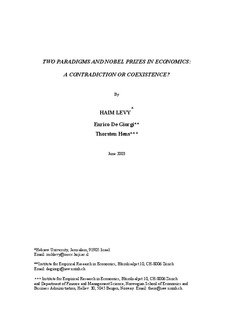Two paradigms and Nobel prizes in economics : a contradiction or coexistence?
Working paper
Permanent lenke
http://hdl.handle.net/11250/163721Utgivelsesdato
2003-06Metadata
Vis full innførselSamlinger
- Discussion papers (FOR) [566]
Sammendrag
Markowitz and Sharpe won the Nobel Prize in Economics more than a decade ago for the development of Mean-Variance analysis and the Capital Asset Pricing Model (CAPM). In the year 2002, Kahneman won the Nobel Prize in Economics for the development of Prospect Theory. Can these two apparently contradictory paradigms coexist? In deriving the CAPM, Sharpe, Lintner and Mossin assume expected utility (EU) maximization following the approach proposed by Markowitz, normal distributions and risk aversion. Kahneman & Tversky suggest Prospect Theory (PT) and Cumulative Prospect Theory (CPT) as an alternative paradigm to EU theory. They show that investors distort probabilities, make decisions based on change of wealth, exhibit loss aversion and maximize the expectation of an S-shaped value function which contains a risk-seeking segment. Employing change of wealth rather than total wealth contradicts EU theory. The subjective distortion of probabilities violates the CAPM assumptions of normality and homogeneous expectations, and the S-shaped value function violates the risk aversion assumption. We prove in this paper that although CPT (and PT) is in conflict to EUT, and violates some of the CAPM’s underlying assumptions, the security market line theorem (SMLT) of the CAPM is intact in the CPT framework.
Utgiver
Norwegian School of Economics and Business Administration. Department of Finance and Management ScienceSerie
Discussion paper2003:9
